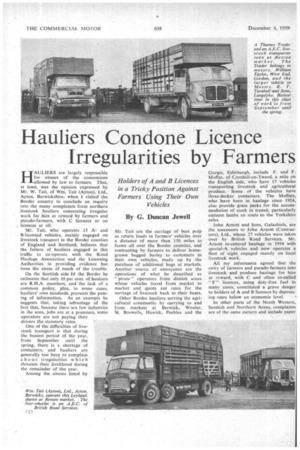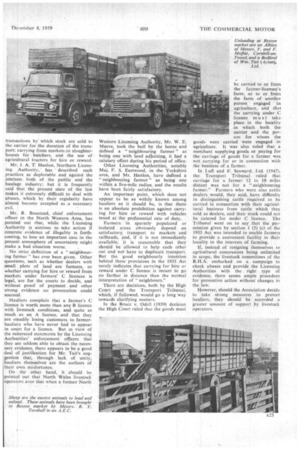Hauliers Condone Licence Irregularities by Farmers
Page 66

Page 67

If you've noticed an error in this article please click here to report it so we can fix it.
HAULIERS are largely responsible for abuses of the concessions allowed by law to farmers. That, at least, was the opinion expressed by Mr. W. Tait, of Wm. Tait (Ayton), Ltd., Ayton, Berwickshire, when I visited the Border country to conclude an inquiry into the many complaints from northern livestock hauliers concerning irregular work for hire or reward by farmers and pseudo-farmers, with C licences or no , licences at all.
Mr. Tait, who operates 13 Aand B-licensed vehicles, mainly engaged on livestock transport in the Border counties of England and Scotland, believes that the failure of hauliers engaged in this traffic to co-operate with the Road Haulage Association and the Licensing Authorities in providing evidence has been the cause of much of the trouble.
On the Scottish side Of the Border he estimates that only 10 per cent, of hauliers are R.H.A. members, and the lack of a common policy, plus, in some cases, hauliers' own misdeeds, prevents the passing of information. As an example he suggests that, taking advantage of the fact that, because there 'are few industries in the area, jobs are at a premium, some operators are not paying their drivers the statutory rates.
One of the difficulties of livestock transport is that during the busiest period of the year, from September until the spring, there is a shortage of containers, and hauliers are generally too busy to complain about irregularities which threaten their livelihood during the remainder of the year.
Among the abuses listed by Mr. Tait are the carriage of beet pulp as return loads in farmers' vehicles over a distance of more than 150 miles to farms all over the Border counties, and contracting by farmers to deliver homegrown bagged barley to customers in their own vehicles, made up by the purchase of additional bags at markets. Another source of annoyance are the operations of what he described as " pirate " operators from distant areas whose vehicles travel from market to market and quote cut rates for the carriage of livestock back to their bases.
Other Border hauliers serving the agricultural community by carrying to and from markets at Berwick, Wooler, St. Boswells, Hawick, Peebles and the Gorgie, Edinburgh, include F. and F. Moffat, of Cornhill-on-Tweed, a mile on the English side, who have 17 vehicles transporting livestock and agricultural produce. Some of the vehicles have three-decker containers. The Moffats, who have been in haulage since 1924, also provide grass parks for the accommodation of stock in transit, particularly autumn lambs en route to the Yorkshire sales.
John Arnott and Sons, Galashiels, are the successors to John Arnott (Contractors), Ltd., whose 27 vehicles were taken over by British Road Services. Mr. Arnott re-entered haulage in 1954 with special-A vehicles and now operates a fleet of eight engaged mainly on local livestock work.
All my informants agreed that the entry of farmers and pseudo-farmers into livestock, and produce haulage for hire or reward, with C and often so-called " F " licences, using duty-free fuel in many cases, constituted a grave danger to holders of A and B licences by depress ing rates below an economic level. • In other parts of the North Western, Scottish and Northern Areas, complaints are of the same pattern and include paper
transactions by which stock are sold to the carrier for the duration of the transport; carrying from marketssto slaughterhouses for butchers, and the use of agricultural tractors for hire or reward.
Mr. J. A. T. Hanlon, Northern Licensing Authority, has described such practices as deplorable and against the interests both of the public and the haulage industry; but it is frequently said that the present state of the law makes it extremely difficult to deal with abuses, which by their regularity have almost become accepted as a necessary evil.
Mr. R. Boustead, chief enforcement officer in the North Western Area, has pointed out that, while the Licensing Authority is anxious to take action if concrete evidence of illegality is forthcoming, to lose an important case in the present atmosphere of uncertainty might make a bad situation worse.
No strict definition of a "neighbouring farmer" has ever been given. Other questions, such as whether dealers with small plots of land are farmers, or whether carrying for hire or reward from markets under farmers' C licences is legal, are for the courts to decide, and without proof of payment and other strong evidence no prosecution could succeed.
Hauliers complain that a farmer's C licence is worth more than any B licence with livestock conditions, and quite as much as an A licence, and that they are steadily losing customers to farmerhauliers who have never had to appear in court for a licence. But in view of the reiterated statements by the Licensing Authorities' enforcement officers that they are seldom able to obtain the necessary evidence, there appears to be a good deal of justification for Mr. Tait's suggestion that, through lack of unity, hauliers themselves are the authors of their own misfortunes.
On the other hand, it should be pointed out that North Wales livestock operators aver that when a former North Western Licensing Authority, Mr. W. E. Macve, took the bull by the horns and defined a "neighbouring farmer" as being one with land adjoining, it had a salutary effect during his period of office.
Other Licensing Authorities, notably Maj. F. S. Eastwood, in the Yorkshire area, and Mr. Hanlon, have &fined a " neighbouring farmer" as being one within a five-mile radius, and the results have been fairly satisfactory.
An important point, which does not appear to be as widely known among hauliers as it should be, is that there is an absolute prohibition against carrying for hire or reward with vehicles taxed at the preferential rate of duty.
Farmers in sparsely populated or isolated areas obviously depend on satisfactory transport to markets and railheads, and, if it is not immediately available, it is reasonable that they should be allowed to help each other out and not have to duplicate transport. But the good neighbourly intention behind these provisions in the 1933 Act surely indicates that carrying for hire or reward under C licence is meant to go no farther in distance than the normal interpretation of "neighbours."
There are decisions, both by the High Court and the Transport Tribunal, which, if followed, would go a long way towards clarifying matters.
In the Bruce v. Odell (1939) decision the High Court ruled that the goods must be carried to or from the farmer-licensee's farm, or to or from the farm of another person engaged in agriculture, and that the carrying under C licence must take place in the locality in which both the carrier and the person for whom the goods were carried were engaged in agriculture. It was also ruled that a merchant supplying goods or paying for the carriage of goods for a farmer was not carrying for or in connection with the business of a farmer.
In Luff and F. Seaward, Ltd. (1947), the Transport Tribunal ruled that carriage for a farmer 12 to 18 miles distant was not for a "neighbouring farmer." Farmers who were also cattle dealers would, they said, have difficulty in distinguishing cattle required to be carried in connection with their agricultural business from cattle which they sold as dealers, and their stock could not be catered for under C licence. The Tribunal went on to say that the permission given by section 1(5) (c) of the 1933 Act was intended to enable farmers to provide a convenient facility in their locality in the interests of farming.
If, instead of resigning themselves to agricultural concessions being unlimited in scope, the livestock committees of the R.H.A. embarked on a campaign to check abuses and provide the Licensing Authorities with the right type of evidence, there seems ample precedent for preventive action without changes in the law.
However, should the Association decide to take strong measures to protect hauliers, they should be accorded a greater amount of support by livestock operators.
























































































































